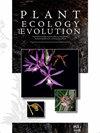Sylvainia, a new monospecific genus within the subtribe Cephalanthinae (Rubiaceae, Naucleeae)
IF 1.1
4区 生物学
Q3 PLANT SCIENCES
引用次数: 0
Abstract
Background and aims – The genus Cephalanthus belongs to the tribe Naucleeae together with 26 other genera. Members of Cephalanthus mainly grow in temperate and subtropical wetlands in the Americas and Asia, but there is a single African species that is associated with forest margins and rocky outcrops in moist temperate grasslands. The genus comprises six species and was historically known to have species with a markedly disjunct distribution: three species are from the Americas: C. glabratus, C. occidentalis, and C. salicifolius; two species are from tropical Asia: C. angustifolius and C. tetrandrus, and one species is from tropical Africa: C. natalensis. Recent molecular phylogenetic studies have supported the monophyly of the genus, however, most of the morphological synapomorphies are absent in the only African species, which is sister to the remaining species of the genus. This work aims to provide a short taxonomic revision of the genus Cephalanthus, taking into consideration morphological aspects previously underestimated or not considered, and to describe a new monospecific genus based on comparative morphological analysis. Material and methods – Vegetative and reproductive material from all the species of Cephalanthus were analysed following conventional taxonomy techniques. Key results – We transferred C. natalensis to a new genus, Sylvainia. Morphological similarities and differences between Cephalanthus and the new genus are discussed. Cephalanthus glabrifolius, a poorly known species and previously considered a synonym of C. tetrandrus, is resurrected as a valid species, bringing the number of species in Cephalanthus to six again. All species are described, illustrated, and their known distributions plotted on regional maps. Conclusion – The subtribe Cephalanthinae now has two genera, its type Cephalanthus with six species, and a new monospecific genus Sylvainia endemic to south-eastern Africa. Based on the amended description of Cephalanthus, now absent from Africa, the generic concept is substantially modified, being represented now by three American and three Asian species.Sylvainia,一个新的单种属,隶属于茜草科牛膝亚科
背景和目的——Cephanthus属与其他26个属一起属于Naucleeae部落。Cephalanthus的成员主要生长在美洲和亚洲的温带和亚热带湿地,但有一个非洲物种与潮湿温带草原的森林边缘和岩石露头有关。该属由六个物种组成,历史上已知有明显不连续分布的物种:三个物种来自美洲:光滑C.glabratus、西洋C.occidentalis和柳C.salicifolius;两个物种来自热带亚洲:狭叶C.angustifolius和防己C.tetrandrus,一个物种来自非洲热带地区:纳他棱藻C.natalensis。最近的分子系统发育研究支持了该属的单系性,然而,大多数形态上的突触形态在唯一的非洲物种中都不存在,该物种是该属其余物种的姐妹。这项工作旨在对Cephalanthus属进行简短的分类学修订,考虑到以前低估或未考虑的形态学方面,并基于比较形态学分析描述一个新的单种属。材料和方法——根据传统的分类学技术分析了所有Cephalanthus物种的营养和繁殖材料。关键结果——我们将纳塔棱藻转移到一个新属Sylvania。讨论了仙头蝶属与新属在形态上的异同。光肩星是一个鲜为人知的物种,以前被认为是毒蜥的同义词,现在作为一个有效的物种复活了,使光肩星中的物种数量再次达到六个。对所有物种进行了描述、说明,并在区域地图上绘制了它们的已知分布图。结论:Cephalanthinae亚族现在有两个属,其模式Cephalanthus有六个物种,以及一个新的单种属Sylvainia,原产于非洲东南部。根据对Cephalanthus的修订描述,该属概念进行了实质性修改,现在由三个美洲和三个亚洲物种代表。
本文章由计算机程序翻译,如有差异,请以英文原文为准。
求助全文
约1分钟内获得全文
求助全文
来源期刊

Plant Ecology and Evolution
PLANT SCIENCES-
CiteScore
2.20
自引率
9.10%
发文量
27
审稿时长
>12 weeks
期刊介绍:
Plant Ecology and Evolution is an international peer-reviewed journal devoted to ecology, phylogenetics and systematics of all ‘plant’ groups in the traditional sense (including algae, cyanobacteria, fungi, myxomycetes), also covering related fields.
The journal is published by Meise Botanic Garden and the Royal Botanical Society of Belgium.
 求助内容:
求助内容: 应助结果提醒方式:
应助结果提醒方式:


